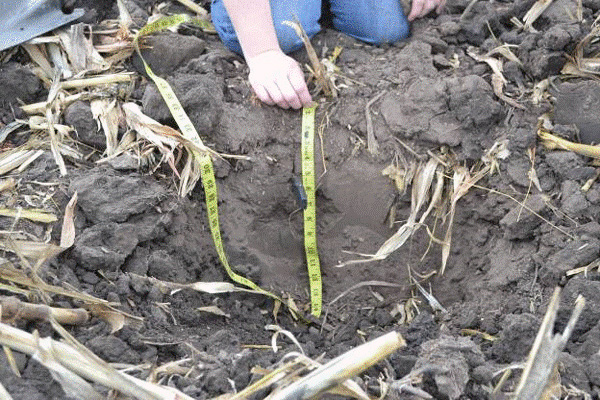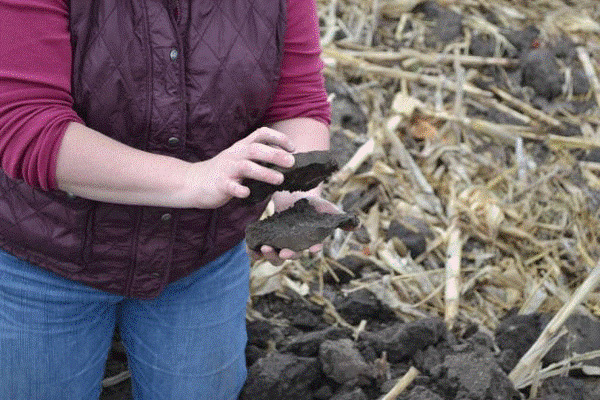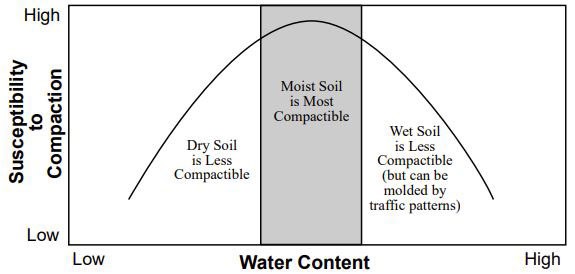Every year, questions arise about soil compaction. Now is a good time to get out and investigate soil profiles for signs of compaction. There is much you can learn by pushing a tile or soil probe into the ground. First, if you have never done so, you can learn something about the soil profile. How many inches of topsoil do you have? At what depth do you encounter changes in soil textures? Topsoil thickness and soil texture are two properties you can’t really control, at least not in the short term. One thing you can certainly look for and work on improving, however, is whether there are any layers of compaction.
Using a spade, soil probe, or tile probe is a good way to learn something about your soil profile and whether there may be a compaction layer. One approach is to dig a small hole about a foot deep as if you were digging a post hole (Figure 1). You can take a knife and poke into the side of the hole, feeling for layers that seem denser or that visually have a platy, compressed soil structure (Figure 2). Use a tape measure to determine the depth at which the dense layers occur. Then, walk to a nearby fence row or waterway and do the same thing. Does this soil look and feel different? How does this compare to the end rows?
 Figure 1. Digging a small hole with a spade is the best way to learn about the soil’s natural and unnatural layers, such as compacted layers. Use a knife to feel for any unusually dense layers, and a tape measure to determine the depth of the layer. Photo by of DeAnn Presley, K-State Research and Extension.
Figure 1. Digging a small hole with a spade is the best way to learn about the soil’s natural and unnatural layers, such as compacted layers. Use a knife to feel for any unusually dense layers, and a tape measure to determine the depth of the layer. Photo by of DeAnn Presley, K-State Research and Extension.

Figure 2. Large pieces of soil that are horizontally oriented, or “platy,” are a sign of compaction. Photo by DeAnn Presley, K-State Research and Extension.
Once you determine the depth at which the compaction occurs, you can work on solutions for improving (decreasing) the density of the compacted layer or the soil in general. If compaction seems limited to the upper 3 inches of the soil profile, then the most likely culprit is traffic. Limiting traffic as much as possible when the soil is wet is a good practice for reducing soil compaction (Figure 3). Running properly inflated tires, using floatation tires, and having more tires in general help to decrease surface compaction.

Figure 3. The amount of soil water is a critical factor in soil compaction potential. Moist soil is the most compactible. Graphic from K-State Research and Extension publication AF115.
A tougher problem to solve is subsurface compaction. If you can feel a layer that is compacted at depths greater than 6 inches, you may be dealing with subsurface compaction. Subsurface compaction should not be confused with a change in the soil texture. It is common to observe changes in the soil texture as you go deeper in the soil profile. Many soils have an increase in clay content in the upper part of the subsoil, which is natural and took a very long time to form. Some soils, such as those in floodplains, might have sandy layers present beneath the surface. This is the reason why the spade/post hole method is really the best, because it allows a person to discover so much more about the soil profile than using a tile probe alone.
How can you prevent compaction?
Deep compaction is caused by heavy axle loads. Research indicates that axle loads greater than 10 tons can cause compaction as deep as 12 to 18 inches, and many modern implements weigh well over 10 tons per axle. The only way to reduce axle weight is to decrease the load weight or add axles — axle load cannot be reduced by adding more or larger tires, unfortunately. Shifting to continuous no-till can help soils become more resistant to subsequent compaction, and long-term research conducted in the Great Plains shows that no-till is more resistant to compaction at wetter soil moisture levels (Figure 2).

Figure 2. Tilled soils are more easily compacted than those under no-till. Also, no-tilled soils can better withstand machinery traffic at higher water contents compared to conventional and reduced-tilled soils; MF3066 Efficient Crop Water Use in Kansas https://www.bookstore.ksre.ksu.edu/pubs/MF3066.pdf (Source of original data: Blanco-Canqui, et al., 2009. No-till induced increase in organic carbon reduces maximum bulk density of soils. Soil Science Society of America Journal 73:1871-1879).





